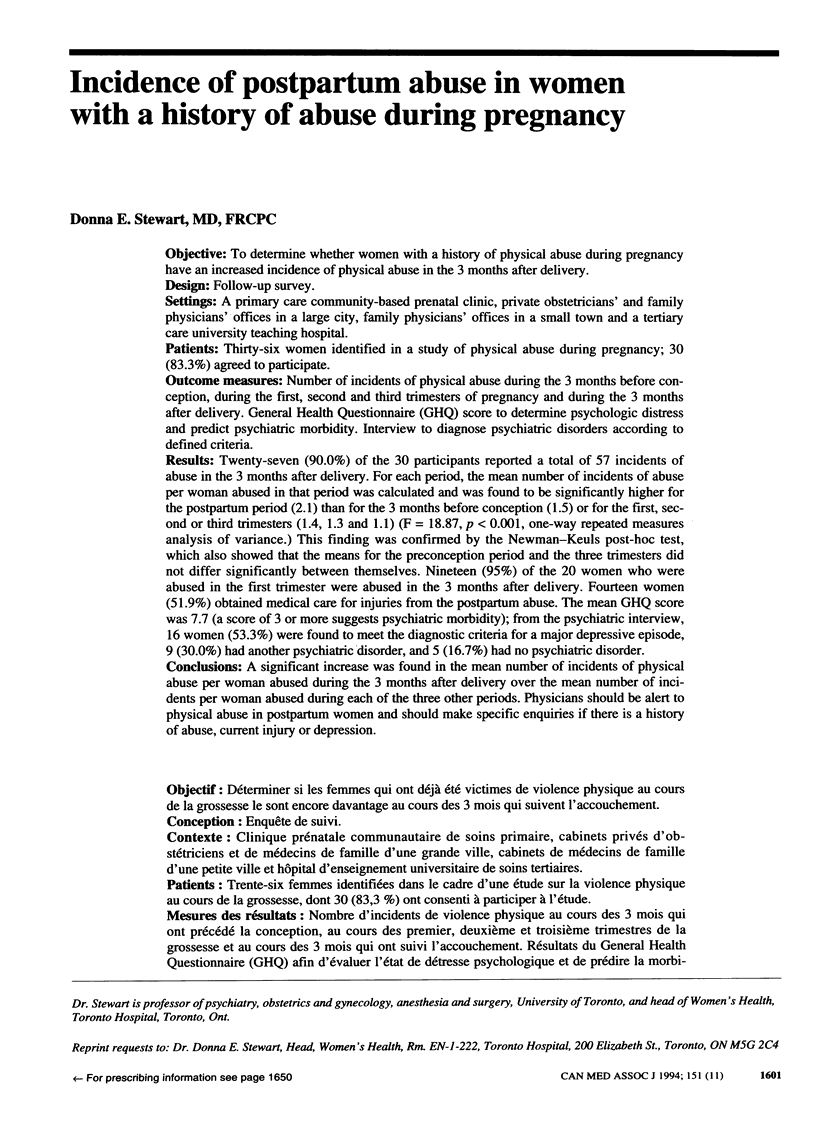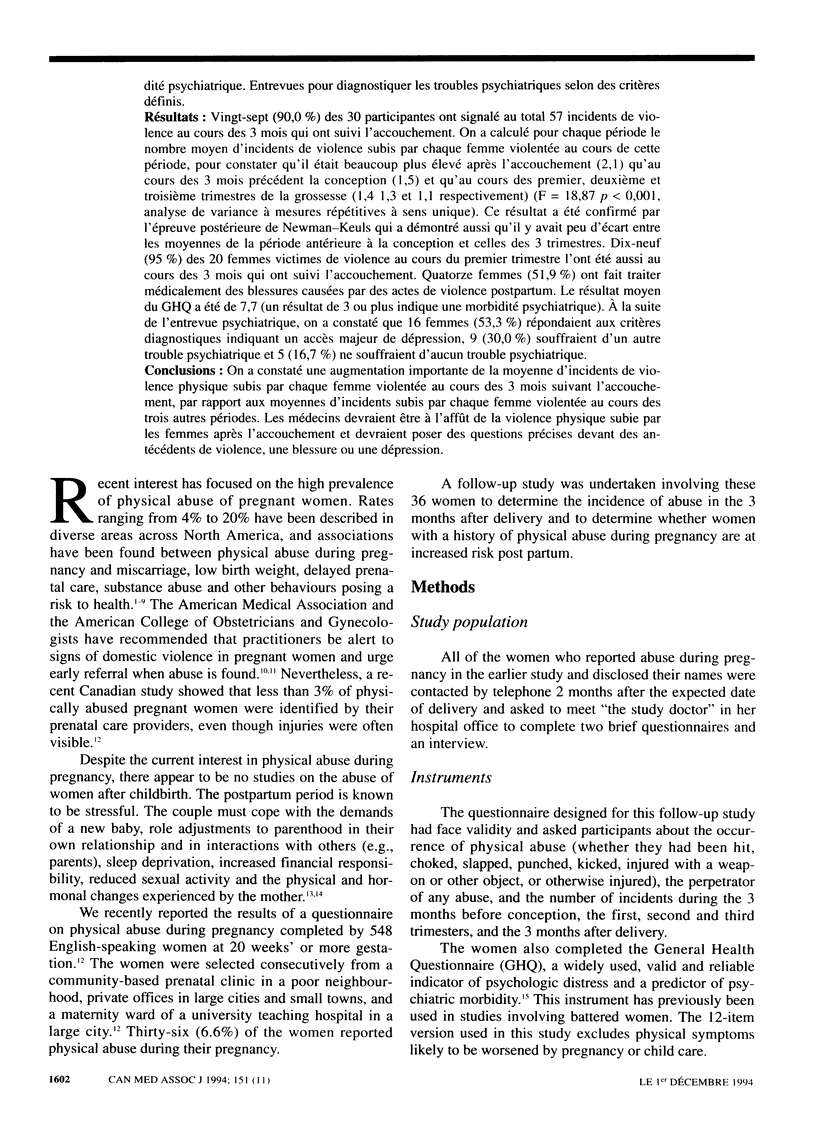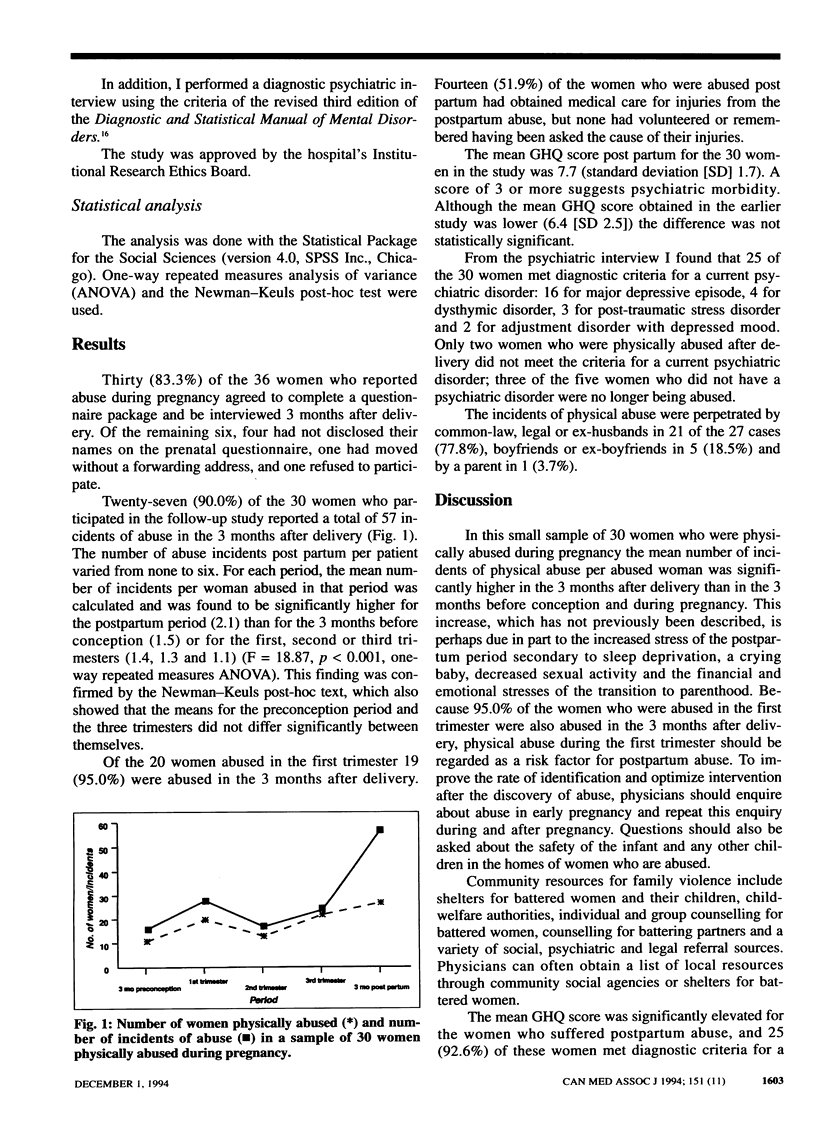Abstract
OBJECTIVE: To determine whether women with a history of physical abuse during pregnancy have an increased incidence of physical abuse in the 3 months after delivery. DESIGN: Follow-up survey. SETTINGS: A primary care community-based prenatal clinic, private obstetricians' and family physicians' offices in a large city, family physicians' offices in a small town and a tertiary care university teaching hospital. PATIENTS: Thirty-six women identified in a study of physical abuse during pregnancy; 30 (83.3%) agreed to participate. OUTCOME MEASURES: Number of incidents of physical abuse during the 3 months before conception, during the first, second and third trimesters of pregnancy and during the 3 months after delivery. General Health Questionnaire (GHQ) score to determine psychologic distress and predict psychiatric morbidity. Interview to diagnose psychiatric disorders according to defined criteria. RESULTS: Twenty-seven (90.0%) of the 30 participants reported a total of 57 incidents of abuse in the 3 months after delivery. For each period, the mean number of incidents of abuse per woman abused in that period was calculated and was found to be significantly higher for the postpartum period (2.1) than for the 3 months before conception (1.5) or for the first, second or third trimesters (1.4, 1.3 and 1.1) (F = 18.87, p < 0.001, one-way repeated measures analysis of variance.) This finding was confirmed by the Newman-Keuls post-hoc test, which also showed that the means for the preconception period and the three trimesters did not differ significantly between themselves. Nineteen (95%) of the 20 women who were abused in the first trimester were abused in the 3 months after delivery. Fourteen women (51.9%) obtained medical care for injuries from the postpartum abuse. The mean GHQ score was 7.7 (a score of 3 or more suggests psychiatric morbidity); from the psychiatric interview, 16 women (53.3%) were found to meet the diagnostic criteria for a major depressive episode, 9 (30.0%) had another psychiatric disorder, and 5 (16.7%) had no psychiatric disorder. CONCLUSIONS: A significant increase was found in the mean number of incidents of physical abuse per woman abused during the 3 months after delivery over the mean number of incidents per woman abused during each of the three other periods. Physicians should be alert to physical abuse in postpartum women and should make specific enquiries if there is a history of abuse, current injury or depression.
Full text
PDF



Selected References
These references are in PubMed. This may not be the complete list of references from this article.
- Amaro H., Fried L. E., Cabral H., Zuckerman B. Violence during pregnancy and substance use. Am J Public Health. 1990 May;80(5):575–579. doi: 10.2105/ajph.80.5.575. [DOI] [PMC free article] [PubMed] [Google Scholar]
- Berenson A. B., Stiglich N. J., Wilkinson G. S., Anderson G. D. Drug abuse and other risk factors for physical abuse in pregnancy among white non-Hispanic, black, and Hispanic women. Am J Obstet Gynecol. 1991 Jun;164(6 Pt 1):1491–1499. doi: 10.1016/0002-9378(91)91428-y. [DOI] [PubMed] [Google Scholar]
- Bohn D. K. Domestic violence and pregnancy. Implications for practice. J Nurse Midwifery. 1990 Mar-Apr;35(2):86–98. doi: 10.1016/0091-2182(90)90064-c. [DOI] [PubMed] [Google Scholar]
- Bullock L. F., McFarlane J. The birth-weight/battering connection. Am J Nurs. 1989 Sep;89(9):1153–1155. [PubMed] [Google Scholar]
- Helton A. S., McFarlane J., Anderson E. T. Battered and pregnant: a prevalence study. Am J Public Health. 1987 Oct;77(10):1337–1339. doi: 10.2105/ajph.77.10.1337. [DOI] [PMC free article] [PubMed] [Google Scholar]
- Hillard P. J. Physical abuse in pregnancy. Obstet Gynecol. 1985 Aug;66(2):185–190. [PubMed] [Google Scholar]
- McFarlane J. Battering during pregnancy: tip of an iceberg revealed. Women Health. 1989;15(3):69–84. doi: 10.1300/J013v15n03_06. [DOI] [PubMed] [Google Scholar]
- McFarlane J., Parker B., Soeken K., Bullock L. Assessing for abuse during pregnancy. Severity and frequency of injuries and associated entry into prenatal care. JAMA. 1992 Jun 17;267(23):3176–3178. doi: 10.1001/jama.267.23.3176. [DOI] [PubMed] [Google Scholar]
- Newberger E. H., Barkan S. E., Lieberman E. S., McCormick M. C., Yllo K., Gary L. T., Schechter S. Abuse of pregnant women and adverse birth outcome. Current knowledge and implications for practice. JAMA. 1992 May 6;267(17):2370–2372. [PubMed] [Google Scholar]
- Randall T. ACOG renews domestic violence campaign, calls for changes in medical school curricula. JAMA. 1992 Jun 17;267(23):3131–3131. [PubMed] [Google Scholar]
- Robinson G. E., Stewart D. E. Postpartum psychiatric disorders. CMAJ. 1986 Jan 1;134(1):31–37. [PMC free article] [PubMed] [Google Scholar]
- Stewart D. E., Cecutti A. Physical abuse in pregnancy. CMAJ. 1993 Nov 1;149(9):1257–1263. [PMC free article] [PubMed] [Google Scholar]


